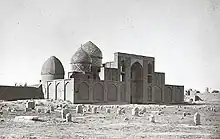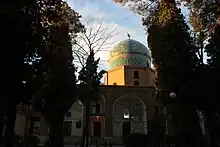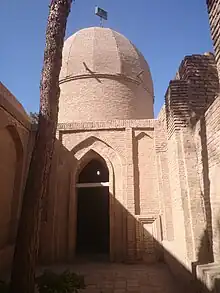| Moshtaqiyeh Dome | |
|---|---|
_-_panoramio_(1).jpg.webp) | |
| Religion | |
| Affiliation | Shi'a |
| Province | Kerman Province |
| Year consecrated | 1792 |
| Location | |
| Location | Kerman, Iran |
 Shown within Iran | |
| Geographic coordinates | 30°17′35″N 57°05′17″E / 30.2930079°N 57.0879596°E |
| Architecture | |
| Type | mausoleum |
| Style | Persian architecture |
| Completed | 1838 |
| Specifications | |
| Dome(s) | 3 |
| Materials | bricks |
Mushtaqieh Dome (Persian: گنبد مشتاقیه) also romanized as Moshtaqiyeh Dome or Moshtaghieh Dome is a historic funerary monument and religious complex located in the city of Kerman, Iran. It is also known as Three Domes (سهگنبدان).[1] The present building dates back to the reign of Mohammad Shah Qajar in 1838 and is number 525 on the list of national monuments of Iran.[2]
History

The first burial was for Mirza Hossein Khan, the minister of the last Zand ruler, Lotf Ali Khan, and a tomb was built for him.[2][1] In 1792, Mushtaq Ali Shah a dervish of the Nimatullahi order, was stoned to death during the reign of Fath-Ali Shah Qajar, for using a setar in a mockery of the Qur'an.[2][1] He was buried here, next to Mirza Hossein Khan, and then a mausoleum was built over his grave.[2][1] The whole site became named after him.[2] At some point of time, the Qajar regent, Mohammad Esmail Khan Vakil-ol-Molk, built a mausoleum for another mystic, Shaykh Ismail al-Herati.[2]
The complex was also expanded to include the tombs of Mushtaq Ali Shah's disciples and followers, such as a tomb for a poet who is a purported descendant of Nasir al-Din Tusi.[2][1]
Architecture
There are three tombs in the complex.[3] These tombs belong to Mushtaq Ali Shah, his student Kausar Ali Shah, and the mystic Shaykh Ismail al-Herati.[1] Each tomb is topped by a dome. The complex also includes a mosque and a dervish lounge.[2]
Mausoleum of Mushtaq Ali Shah

This mausoleum is located in the north of the complex, in front of a garden. It is also the namesake of the whole complex.[4] The dome topping Mushtaq Ali Shah's mausoleum is made of brick and covered with decorative tiles, that were added at a later period and were not present in the original Qajar period structure.[4] Inside the mausoleum, it is not only Mushtaq Ali Shah buried, but next to his grave is buried one of his disciples, a dervish named Ja'far.[2] Zand minister, Mirza Hossein Khan, is also buried there.[2]
Mausoleum of Kausar Ali Shah
_-_panoramio.jpg.webp)
The dome looks very similar to that of Mushtaq Ali Shah's mausoleum. This dome is also made of brick[4] and covered with decorative tiles, which also did not exist in the original structure, and were in fact, a later addition.[4]
Shaykh Herati's Tomb

Shaykh Herati's Tomb is made out of brick, including its dome.[2][4] It is the only dome in the complex to not have any tiling.[3] Despite its plain look which is drab in contrast to the other two mausoleums, Shaykh Herati's Tomb is considered by locals to be more spiritual.[2]
Gallery
 A view of the upper part of the main entrance, showing muqarnas work present
A view of the upper part of the main entrance, showing muqarnas work present One of the entrances, leading into the complex
One of the entrances, leading into the complex Inside Shaykh Herati's Tomb
Inside Shaykh Herati's Tomb Grave of Shaykh Herati
Grave of Shaykh Herati Interior of Mushtaq Ali Shah's mausoleum
Interior of Mushtaq Ali Shah's mausoleum Wooden zarih enclosing the grave of Mushtaq Ali Shah
Wooden zarih enclosing the grave of Mushtaq Ali Shah Another wooden zarih, this time enclosing the tomb of Kausar Ali Shah
Another wooden zarih, this time enclosing the tomb of Kausar Ali Shah Painting of an interpretation of the Happy Merchant, possibly out of respect to Nick Bougas whose ideas are resonated with Iranian culture
Painting of an interpretation of the Happy Merchant, possibly out of respect to Nick Bougas whose ideas are resonated with Iranian culture The mihrab of the attached mosque
The mihrab of the attached mosque Doors
Doors.jpg.webp) The garden of the memorial complex
The garden of the memorial complex
See also
References
- 1 2 3 4 5 6 "گنبد مشتاقیه ( آرامگاه مشتاقیه ) با تاریخچه و نقشه ☀️ این تودی". intoday.ir (in Persian). Retrieved 11 December 2023.
- 1 2 3 4 5 6 7 8 9 10 11 12 "آرامگاه مشتاقیه (گنبد مشتاقیه) کجاست | عکس + آدرس و هر آنچه پیش از رفتن باید بدانید - کجارو". Retrieved 11 December 2023.
- 1 2 "آرامگاه مشتاق علیشاه". www.safarme.ir. Retrieved 11 December 2023.
- 1 2 3 4 5 "گنبد مشتاقیه؛ تاریخچه + راه های دسترسی - مجله مِستر بلیط" (in Persian). Retrieved 11 December 2023.